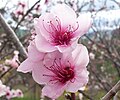Peach
| Peach | |
|---|---|

| |
| Peach flower, fruit, seed and leaves as illustrated by Otto Wilhelm Thomé (1885) | |

| |
| Autumn Red peaches, cross section showing freestone variety | |
| Scientific classification | |
| Kingdom: | Plantae |
| Clade: | Tracheophytes |
| Clade: | Angiosperms |
| Clade: | Eudicots |
| Clade: | Rosids |
| Order: | Rosales |
| Family: | Rosaceae |
| Genus: | Prunus |
| Subgenus: | Prunus subg. Amygdalus
|
| Species: | P. persica
|
| Binomial name | |
| Prunus persica | |
| Synonyms[2] | |
|
Synonymy
| |
The peach (Prunus persica) is a
with various characteristics, most called peaches and others (the glossy-skinned, non-fuzzy varieties), nectarines.The specific name persica refers to its widespread cultivation in
Peaches and nectarines are the same species, though they are regarded commercially as different fruits. The skin of nectarines lacks the fuzz (fruit-skin trichomes) that peach skin has; a mutation in a single gene (MYB25) is thought to be responsible for the difference between the two.[6][7]
In 2018, China produced 62% of the world total of peaches and nectarines. Spain, Italy, Turkey and Greece, all situated in the Mediterranean region, are prominent producers of peaches.[8]
Description
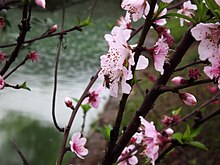
Prunus persica trees grow up to 7 m (23 ft) tall and wide, but when pruned properly, they are usually 3–4 m (10–13 ft) tall and wide.
Cultivated peaches are divided into
Peach trees are relatively short-lived as compared with some other fruit trees. In some regions orchards are replanted after 8 to 10 years, while in others trees may produce satisfactorily for 20 to 25 years or more, depending upon their resistance to diseases, pests, and winter damage.[11]
Etymology
The scientific name persica, along with the word "peach" itself – and its cognates in many European languages – derives from an early European belief that peaches were native to
Fossil record
Fossil
History
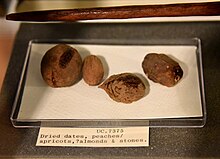
Although its botanical name Prunus persica refers to Persia, genetic studies suggest peaches originated in China,
A domesticated peach appeared very early in Japan, in 4700–4400 BC, during the Jōmon period. It was already similar to modern cultivated forms, where the peach stones are significantly larger and more compressed than earlier stones. This domesticated type of peach was brought into Japan from China. Nevertheless, in China itself, this variety is currently attested only at a later date around 3300 to 2300 BC.[18]
In India, the peach first appeared by about 1700 BC, during the
It is also found elsewhere in
An article on peach tree cultivation in Spain is brought down in
The Shanghai honey nectar peach was a key component of both the food culture and agrarian economy the area where the modern megacity of Shanghai stands. Peaches were the cornerstone of early Shanghai's garden culture. As modernization and westernization swept through the city the Shanghai honey nectar peach nearly disappeared completely. Much of modern Shanghai is built over these gardens and peach orchards.[27]
In April 2010, an international consortium, the International Peach Genome Initiative, which includes researchers from the United States, Italy, Chile, Spain, and France, announced they had sequenced the peach tree genome (doubled haploid Lovell). Recently, it published the peach genome sequence and related analyses. The sequence is composed of 227 million nucleotides arranged in eight pseudomolecules representing the eight peach chromosomes (2n = 16). In addition, 27,852 protein-coding genes and 28,689 protein-coding transcripts were predicted.
Particular emphasis in this study is reserved for the analysis of the genetic diversity in peach germplasm and how it was shaped by human activities such as domestication and breeding. Major historical bottlenecks were found, one related to the putative original domestication that is supposed to have taken place in China about 4,000–5,000 years ago, the second is related to the western germplasm and is due to the early dissemination of the peach in Europe from China and the more recent breeding activities in the United States and Europe. These bottlenecks highlighted the substantial reduction of genetic diversity associated with domestication and breeding activities.[28]
Peaches in the Americas
Peaches were introduced into the Americas in the 16th century by the Spanish. By 1580, peaches were being grown in Latin America and were cultivated by the remnants of the Inca Empire in Argentina.[29]
In the United States the peach was soon adopted as a crop by
Peach plantations became an objective of American military campaigns against the Indians. In 1779, the Sullivan Expedition destroyed the livelihood of many of the Iroquois people of New York. Among the crops destroyed were plantations of peach trees.[32] In 1864, Kit Carson led a successful U.S. army expedition to Canyon de Chelly, Arizona to destroy the livelihood of the Navajo. Carson destroyed thousands of peach trees. A soldier said they were the "best peach trees I have ever seen in the country, every one of them bearing fruit.” [33]
Cultivation
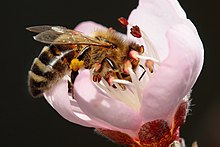
Peaches grow in a fairly limited range in dry, continental or temperate climates, since the trees have a chilling requirement that tropical or subtropical areas generally do not satisfy except at high altitudes (for example in certain areas of Ecuador, Colombia, Ethiopia, India, and Nepal). Most cultivars require 500 hours of chilling around 0 to 10 °C (32 to 50 °F). During the chilling period, key chemical reactions occur, but the plant appears dormant. Once the chilling period is fulfilled, the plant enters a second type of dormancy, the quiescence period. During quiescence, buds break and grow when sufficient warm weather favorable to growth is accumulated.[34]
The trees themselves can usually tolerate temperatures to around −26 to −30 °C (−15 to −22 °F), although the following season's flower buds are usually killed at these temperatures, preventing a crop that summer. Flower bud death begins to occur between −15 and −25 °C (5 and −13 °F), depending on the cultivar and on the timing of the cold, with the buds becoming less cold tolerant in late winter.[35]
Another climate constraint is spring frost. The trees flower fairly early (in March in Western Europe), and the blossom is damaged or killed if temperatures drop below about −4 °C (25 °F). If the flowers are not fully open, though, they can tolerate a few degrees colder.[36]
Climates with significant winter rainfall at temperatures below 16 °C (61 °F) are also unsuitable for peach cultivation, as the rain promotes peach leaf curl, which is the most serious fungal disease for peaches. In practice, fungicides are extensively used for peach cultivation in such climates, with more than 1% of European peaches exceeding legal pesticide limits in 2013.[37]
Finally, summer heat is required to mature the crop, with mean temperatures of the hottest month between 20 and 30 °C (68 and 86 °F).
Typical peach cultivars begin bearing fruit in their third year. Their lifespan in the U.S. varies by region; the
Cultivars
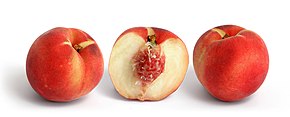
Hundreds of peach and nectarine cultivars are known. These are classified into two categories—freestones and clingstones. Freestones are those whose flesh separates readily from the pit. Clingstones are those whose flesh clings tightly to the pit. Some cultivars are partially freestone and clingstone, so are called semifree. Freestone types are preferred for eating fresh, while clingstone types are for canning. The fruit flesh may be creamy white to deep yellow, to dark red; the hue and shade of the color depend on the cultivar.[40]
Peach breeding has favored cultivars with more firmness, more red color, and shorter fuzz on the fruit surface. These characteristics ease shipping and supermarket sales by improving eye appeal. This selection process has not necessarily led to increased flavor, though. Peaches have a short shelf life, so commercial growers typically plant a mix of different cultivars to have fruit to ship all season long.[41]
Different countries have different cultivars. In the United Kingdom, for example, these cultivars have gained the Royal Horticultural Society's Award of Garden Merit:
For China specifically see Peach production in China § Cultivars.
Nectarines
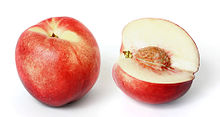
The variety P. persica var. nucipersica (or var. nectarina) – these are commonly called nectarines – has a smooth skin. It is on occasion referred to as a "shaved peach" or "fuzzless peach", due to its lack of fuzz or short hairs. Though fuzzy peaches and nectarines are regarded commercially as different fruits, with nectarines often erroneously believed to be a crossbreed between peaches and
As with peaches, nectarines can be white or yellow, and clingstone or freestone. On average, nectarines are slightly smaller and sweeter than peaches, but with much overlap.[6] The lack of skin fuzz can make nectarine skins appear more reddish than those of peaches, contributing to the fruit's plum-like appearance. The lack of down on nectarines' skin also means their skin is more easily bruised than peaches.
The history of the nectarine is unclear; the first recorded mention in English is from 1616,[46] but they had probably been grown much earlier within the native range of the peach in central and eastern Asia. Although one source states that nectarines were introduced into the United States by David Fairchild of the Department of Agriculture in 1906,[47] a number of colonial-era newspaper articles make reference to nectarines being grown in the United States prior to the Revolutionary War. The 28 March 1768 edition of the New York Gazette (p. 3), for example, mentions a farm in Jamaica, Long Island, New York, where nectarines were grown.
Peacherines
Peacherines are claimed to be a cross between a peach and a nectarine, but as they are the same species cannot be a true cross (hybrid); they are marketed in Australia and New Zealand. The fruit is intermediate in appearance, though, between a peach and a nectarine, large and brightly colored like a red peach. The flesh of the fruit is usually yellow, but white varieties also exist. The Koanga Institute lists varieties that ripen in the Southern Hemisphere in February and March.[48][49]
In 1909, Pacific Monthly mentioned peacherines in a news bulletin for California. Louise Pound, in 1920, claimed the term peacherine is an example of language stunt.[50]
Flat peaches
Flat peaches, or pan-tao, have a flattened shape, in contrast to ordinary near-spherical peaches.[51]
Planting
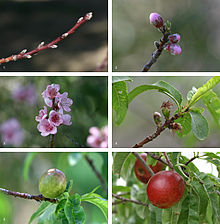
Most peach trees sold by nurseries are cultivars
Peach trees need full sun, and a layout that allows good natural air flow to assist the thermal environment for the tree. Peaches are planted in early winter. During the growth season, they need a regular and reliable supply of water, with higher amounts just before harvest.[53]
Peaches need nitrogen-rich fertilizers more than other fruit trees. Without regular fertilizer supply, peach tree leaves start turning yellow or exhibit stunted growth. Blood meal, bone meal, and calcium ammonium nitrate are suitable fertilizers.
The flowers on a peach tree are typically thinned out because if the full number of peaches mature on a branch, they are undersized and lack flavor. Fruits are thinned midway in the season by commercial growers. Fresh peaches are easily bruised, so do not store well. They are most flavorful when they ripen on the tree and are eaten the day of harvest.[53]
The peach tree can be grown in an espalier shape. The Baldassari palmette is a design created around 1950 used primarily for training peaches. In walled gardens constructed from stone or brick, which absorb and retain solar heat and then slowly release it, raising the temperature against the wall, peaches can be grown as espaliers against south-facing walls as far north as southeast Great Britain and southern Ireland.
Insects
The first
The larvae of such
The tree is also a host plant for such species as the Japanese beetle (Popillia japonica), the unmonsuzume (Callambulyx tatarinovii), the promethea silkmoth (Callosamia promethea), the orange oakleaf (Kallima inachus), Langia zenzeroides, the speckled emperor (Gynanisa maja) or the brown playboy (Deudorix antalus). The European red mite (Panonychus ulmi) or the yellow mite (Lorryia formosa) are also found on the peach tree.
It is a good
Diseases
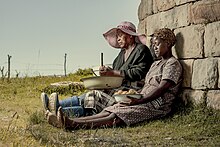
Peach trees are prone to a disease called
or a dark reddish spot.Storage
Peaches and nectarines are best stored at temperatures of 0 °C (32 °F) and in high humidity.[40] They are highly perishable, so are typically consumed or canned within two weeks of harvest.
Peaches are climacteric[56][57][58] fruits and continue to ripen after being picked from the tree.[59]
Production
| Peach (and nectarine) production, 2020 | ||
|---|---|---|
| Country | Production (millions of tonnes) | |
| 15.00 | ||
| 1.31 | ||
| 1.02 | ||
| 0.89 | ||
| 0.89 | ||
| 0.66 | ||
| 0.56 | ||
| World | 24.57 | |
| Source: United Nations, FAOSTAT[8] | ||
In 2020, world production of peaches (combined with nectarines for reporting) was 24.6 million tonnes, led by China with 61% of the world total (table).
The U.S. state of Georgia is known as the "Peach State" due to its significant production of peaches as early as 1571,[60] with exports to other states occurring around 1858.[61] In 2014, Georgia was third in US peach production behind California and South Carolina.[60] The largest peach producing countries in Latin America are Argentina, Brazil, Chile, and Mexico.[62]
Cultural significance
Peaches are not only a popular fruit, but also are symbolic in many cultural traditions, such as in art, paintings, and folk tales such as the Peaches of Immortality.
China
Peach blossoms are highly prized in Chinese culture. The ancient Chinese believed the peach to possess more vitality than any other tree because their blossoms appear before leaves sprout. When early rulers of China visited their territories, they were preceded by sorcerers armed with peach rods to protect them from spectral evils. On New Year's Eve, local magistrates would cut peach wood branches and place them over their doors to protect against evil influences.
The Chinese also considered peach wood (t'ao-fu) protective against evil spirits, who held the peach in awe. In ancient China, peach-wood bows were used to shoot arrows in every direction in an effort to dispel evil. Peach-wood slips or carved pits served as amulets to protect a person's life, safety, and health.[64]
Peachwood seals or figurines guarded gates and doors, and, as one Han account recites, "the buildings in the capital are made tranquil and pure; everywhere a good state of affairs prevails".[64] Writes the author, further:
Another aid in fighting evil spirits were peach-wood wands. The Li-chi (Han period) reported that the emperor went to the funeral of a minister escorted by a sorcerer carrying a peachwood wand to keep bad influences away. Since that time, peachwood wands have remained an important means of exorcism in China.[64]
Peach kernels (桃仁 táo rén) are a common ingredient used in traditional Chinese medicine to dispel blood stasis, counter inflammation, and reduce allergies.[65]
In an orchard of flowering peach trees, Liu Bei, Guan Yu, and Zhang Fei took an oath of brotherhood in the opening chapter of the classic Chinese novel Romance of the Three Kingdoms. Another peach orchard, in "The Peach Blossom Spring" by poet Tao Yuanming, is the setting of the favourite Chinese fable and a metaphor for utopias. A peach tree growing on a precipice was where the Taoist master Zhang Daoling tested his disciples.[66]
The
The term "
Korea
In Korea, peaches have been cultivated from ancient times. According to
Japan

The world's sweetest peach is grown in Fukushima, Japan. The Guinness world record for the sweetest peach is currently held by a peach grown in Kanechika, Japan, with a sugar content of 22.2%. However, a fruit farm in rural Fukushima, Koji grew a much sweeter peach, with a Brix score of 32°. Degrees Brix measures the sugar content of the fruit, and is usually between 11 and 15 for a typical peach from a supermarket.[69]
Momotarō, a folktale character, is named after the giant peach from which he was birthed.
Two traditional Japanese words for the color pink correspond to blossoming trees: one for peach blossoms (momo-iro), and one for cherry blossoms (sakura-iro).
Vietnam
A Vietnamese mythic history states that in the spring of 1789, after marching to Ngọc Hồi and then winning a great victory against invaders from the Qing dynasty of China, Emperor Quang Trung ordered a messenger to gallop to Phú Xuân citadel (now Huế) and deliver a flowering peach branch to the Empress Ngọc Hân. This took place on the fifth day of the first lunar month, two days before the predicted end of the battle. The branch of peach flowers that was sent from the north to the centre of Vietnam was not only a message of victory from the Emperor to his consort, but also the start of a new spring of peace and happiness for all the Vietnamese people. In addition, since the land of Nhật Tân had freely given that very branch of peach flowers to the Emperor, it became the loyal garden of his dynasty.
The protagonists of The Tale of Kieu fell in love by a peach tree, and in Vietnam, the blossoming peach flower is the signal of spring. Finally, peach bonsai trees are used as decoration during Vietnamese New Year (Tết) in northern Vietnam.[citation needed]
Europe
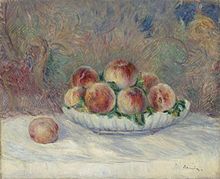
Many famous artists have painted with peach fruits placed in prominence.
In literature, Roald Dahl named his children's fantasy novel James and the Giant Peach because a peach is "prettier, bigger and squishier than a cherry."[74]
United States

South Carolina named the peach its official fruit in 1984.[75] The peach became the state fruit of Georgia, nicknamed the "Peach State", in 1995.[76] The peach went from feral trees utilized opportunistically to a tended commercial crop in the Southern United States in the 1850s, as the boll weevil attacked regional cotton crops. When Georgia reached peak production in the 1920s, elaborate festivals celebrated the fruit. By 2017, Georgia's production represented 3–5% of the U.S. total.[77][78] Alabama named it the "state tree fruit" in 2006.[79] Delaware's state flower has been the peach blossom since 1995,[80] and peach pie became its official dessert in 2009.[81]
Nutrition
| Nutritional value per 100 g (3.5 oz) | |
|---|---|
| Energy | 165 kJ (39 kcal) |
9.54 g | |
| Sugars | 8.39 g |
| Dietary fiber | 1.5 g |
0.25 g | |
0.91 g | |
Niacin (B3) | 5% 0.806 mg |
| Pantothenic acid (B5) | 3% 0.153 mg |
| Vitamin B6 | 1% 0.025 mg |
| Folate (B9) | 1% 4 μg |
| Choline | 1% 6.1 mg |
| Vitamin C | 7% 6.6 mg |
| Vitamin E | 5% 0.73 mg |
| Vitamin K | 2% 2.6 μg |
| Minerals | Quantity %DV† |
| Calcium | 0% 6 mg |
| Iron | 1% 0.25 mg |
| Magnesium | 2% 9 mg |
| Manganese | 3% 0.061 mg |
| Phosphorus | 2% 20 mg |
| Potassium | 6% 190 mg |
| Sodium | 0% 0 mg |
| Zinc | 2% 0.17 mg |
| Other constituents | Quantity |
| Water | 89 g |
| †Percentages estimated using US recommendations for adults,[82] except for potassium, which is estimated based on expert recommendation from the National Academies.[83] | |
Raw peach flesh is 89% water, 10%
One medium peach also contains 2% or more daily value of vitamins E and K, niacin, folate, iron, choline, potassium, magnesium, phosphorus, manganese, zinc and copper. Fresh peaches are a moderate source of antioxidants and vitamin C which is required for the building of connective tissue inside the human body.[86]
Phytochemicals
Total
Red-fleshed peaches are rich in anthocyanins,[91] particularly cyanidin glucosides in six peach and six nectarine cultivars[92] and malvin glycosides in clingstone peaches.[90] As with many other members of the
Peach
Aroma
Some 110 chemical compounds contribute to peach aroma, including
Gallery
-
Peach blossoms
-
Incipient fruit development
-
Peaches on tree
-
Peaches in a basket
Paintings
-
Portrait of Isabella and John Stewart by Charles Willson Peale, 1774
-
Still Life Basket of Peaches by Raphaelle Peale, 1816
-
A Jar of Peaches by Claude Monet c. 1866
-
"Spring 4, peach-blossoms and green pheasants" by Kōno Bairei, 1883
-
Peach (cultivar 'Berry'), watercolour, 1895
References
- ^ "IPNI Plant name Query Results". ipni.org. Archived from the original on 25 September 2015.
- ^ The Plant List, Prunus persica (L.) Batsch
- ^ PMID 25192436.
- ^ "Almond Tree - Learn About Nature". 27 July 2016. Retrieved 8 April 2022.
- PMID 23495652.
- ^ a b c "Frequently Asked Questions". Oregon State University. Archived from the original on 14 July 2008.
- PMID 24595269.
- ^ a b "Production of peaches and nectarines in 2018; Crops/Regions/World/Production Quantity (from pick lists)". United Nations, Food and Agricultural Organization, Statistics Division (FAOSTAT). 2019. Retrieved 11 April 2020.
- ^ "The Average Width of a Peach Tree". SFGate. Hearst Communications Inc. 4 March 2013. Retrieved 23 October 2018.
- ^ "Indian Peaches Information, Recipes and Facts". Specialtyproduce.com. Archived from the original on 20 September 2012. Retrieved 24 September 2012.
- ^ "peach | Fruit, Description, History, Cultivation, Uses, & Facts | Britannica". www.britannica.com. Retrieved 11 October 2022.
- ISBN 0-262-53267-0.
- PMID 26610240.
- ISBN 978-0-520-05629-9.
- ISBN 978-81-89422-69-1.
- ^ ISBN 978-0-19-160949-7.
- ISBN 978-1-84593-386-9.
- PMID 25192436.
- ^ Fuller, D; Madella, M (2001). "Issues in Harappan Archaeobotany: Retrospect and Prospect". In Settar, S; Korisettar, R (eds.). Indian Archaeology in Retrospect. Vol. II. Protohistory. New Delhi: Manohar. pp. 317–390.
- ^ ISBN 0-8493-8980-1.
- ISBN 0-19-211579-0.
- ^ Sadori, Laura; et al. (2009). "The introduction and diffusion of peach in ancient Italy" (PDF). Edipuglia. Archived from the original (PDF) on 14 January 2013.
- ^ Noah Blan, 'Charlemagne's Peaches: A Case of Early Medieval European Ecological Adaptation', Early Medieval Europe, 27.4 (2019), 521–45.
- –319 (Article XLI)
- ^ "George Minifie". Genforum.genealogy.com. 21 March 1999. Archived from the original on 14 January 2013. Retrieved 24 September 2012.
- ^ Fogle, H. W. (1965). Peach Production East of the Rocky Mountains. Agricultural Research Service, U.S. Department of Agriculture. p. 1.
- ISBN 978-0-8047-6012-6.
- PMID 23525075.
- )
- JSTOR 3741756.
- ^ "Peaches". Jefferson Monticello. Jefferson Encyclopedia. Retrieved 7 November 2023.
- ^ "Clinton-Sullavan Expedition of 1779". National Park Service. Retrieved 7 November 2023.
- ^ Sumiak, Dennis (15 August 2017). "Navajo Will Never Forget the 1864 Scorched Earth Campaign". History Net.
- ^ "Peach tree physiology" (PDF). University of Georgia. 2007. Archived from the original (PDF) on 10 June 2010.
- .
- doi:10.21273/HORTSCI.51.7.816.)
{{cite journal}}: CS1 maint: multiple names: authors list (link - from the original on 15 March 2015.
The highest maximum residue level (MRL) exceedance rate was found for strawberries (2.5% of the samples), followed by lettuce (2.3%), oats (1.3%), peaches (1.1%), and apples (1.0%).
- University of California at Davis. November 2009. Archived(PDF) from the original on 12 June 2010. Retrieved 25 August 2015.
- ^ "Growing Peaches in Maine". Archived from the original on 26 August 2015. Retrieved 25 August 2015.
- ^ a b "Peach and Nectarine Culture". University of Rhode Island. 2000. Archived from the original on 14 January 2013.
- ^ Okie, W.R. (2005). "Varieties – Peaches" (PDF). United States Department of Agriculture. Archived from the original (PDF) on 14 January 2013.
- ^ "RHS Plant Selector Prunus persica 'Duke of York' (F) AGM / RHS Gardening". Apps.rhs.org.uk. Archived from the original on 14 January 2013. Retrieved 24 September 2012.
- ^ "RHS Plant Selector Prunus persica 'Peregrine' (F) AGM / RHS Gardening". Apps.rhs.org.uk. Archived from the original on 14 January 2013. Retrieved 24 September 2012.
- ^ "RHS Plant Selector Prunus persica 'Rochester' (F) AGM / RHS Gardening". Apps.rhs.org.uk. Archived from the original on 14 January 2013. Retrieved 24 September 2012.
- ^ "RHS Plant Selector Prunus persica var. nectarina 'Lord Napier' (F) AGM / RHS Gardening". Apps.rhs.org.uk. Archived from the original on 14 January 2013. Retrieved 24 September 2012.
- ^ Oxford English Dictionary
- ^ Fairchild, David (1938). The World Was My Garden. New York: Charles Scribner's Sons. p. 226.
- ^ "Almonds, Nectarines, Peacherines and Apricots". Koanga Institute. Archived from the original on 15 February 2014. Retrieved 8 January 2014.
- ^ Shimabukuro, Betty (7 July 2004). "Mixed marriages: Cross-pollination produces fruit "children" that aren't quite the same as mom and dad". Honolulu Star-Bulletin. Archived from the original on 2 March 2012. Retrieved 8 January 2014.
- JSTOR 802441.
- ISBN 978-1-84593-386-9. Retrieved 3 August 2015.
- ^ Ingels, Chuck; et al. (2007). The Home Orchard: Growing Your Own Deciduous Fruit and Nut Trees. University of California Agriculture and Natural Resources. pp. 29–30.
- ^ a b McCraw, Dean. "Planting and Early Care of the Peach Orchard". Oklahoma Cooperative Extension Service. Archived (PDF) from the original on 16 September 2012.
- ^ "Wer frisst Pfirsich-Blütenknopsen?" [Who eats peach blossom buds?]. Garten-pur.de (in German). 9 April 2010. Archived from the original on 2 January 2014. Retrieved 1 January 2014.
- UC Davis. 10 September 2015. Archivedfrom the original on 19 January 2016. Retrieved 3 November 2015.
- PMID 17925301.
- S2CID 81245874.
- ^ "Prunus persica, peach, nectarine". GeoChemBio.com. Archived from the original on 25 July 2012. Retrieved 24 September 2012.
- ^ "Healthy and Sustainable Food". The Center for Health and the Global Environment. Harvard Medical School. 16 November 2011. Archived from the original on 11 February 2012. Retrieved 24 September 2012.
- ^ a b Kathryn C. Taylor (15 August 2003). "Peaches". New Georgia Encyclopedia. Georgia Humanities Council and the University of Georgia Press. Archived from the original on 5 July 2015. Retrieved 3 August 2015.
- ^ Fair, John D. (2002). "The Georgia Peach and the Southern Quest for Commercial Equity and Independence, 1843–1861". Georgia Historical Quarterly. 86 (3): 372. Retrieved 19 February 2018.
- ^ "Fresh Peach and Nectarine Productions in Latin America in 2021 by country". Statista.
- ISBN 9781462268412.
- ^ ISBN 0-8493-8804-X.
- ^ "TCM: Peach kernels" (in Chinese). Archived from the original on 16 July 2011. Retrieved 1 November 2010.
- ISBN 978-0-7914-3955-5. Archivedfrom the original on 16 May 2016.
- Britannica. Archived from the originalon 24 May 2012. Retrieved 12 January 2010.
- ^ 복숭아 [Peach] (in Korean). Nate / Encyclopedia of Korean culture. Archived from the original on 24 May 2012. Retrieved 12 January 2010.
- ^ "The world's sweetest peach costs $7,000. So is it worth the price tag?". www.abc.net.au. 17 July 2020. Retrieved 18 July 2020.
- PMID 20085943.
- ^ a b Jules Janick. "Caravaggio's Fruit: A Mirror on Baroque Horticulture" (PDF). Archived from the original (PDF) on 14 January 2013. Retrieved 24 September 2012.
- ^ de Groft, Aaron H. (2006). "Caravaggio – Still Life with Fruit on a Stone Ledge" (PDF). Papers of the Muscarelle Museum of Art, Volume 1. Archived from the original (PDF) on 14 January 2013.
- ISBN 978-0-8118-4282-2.
- ^ "Roald Dahl Day: Seven fantastic facts about the author". BBC. Retrieved 17 October 2022.
- ^ Plants & Edibles, South Carolina Legislature Online, retrieved 29 May 2019
- ^ "State Fruit". Georgia State Symbols. Georgia Secretary of State. Archived from the original on 29 May 2019. Retrieved 29 May 2019.
- ^ Okie, William Thomas (14 August 2017), "The Fuzzy History of the Georgia Peach", Smithsonian.com, retrieved 29 May 2019
- ^ Mackie, Matt (1 November 2018), "Is Georgia really the Peach State?", wxga.com, retrieved 29 May 2019
- ^ "State Tree Fruit of Alabama". Alabama Emblems, Symbols and Honors. Alabama Department of Archives and History. 20 April 2006. Archived from the original on 15 April 2008. Retrieved 29 May 2019.
- ^ "Delaware State Plants". Delaware.gov. Retrieved 30 May 2019.
- ^ "Delaware Miscellaneous Symbols". Delaware.gov. Retrieved 29 May 2019.
- ^ United States Food and Drug Administration (2024). "Daily Value on the Nutrition and Supplement Facts Labels". Retrieved 28 March 2024.
- )
- ^ "Nutrition Facts for Nectarines, raw, per 100 g". Conde Nast, USDA National Nutrient Database, version SR-21. 2014. Archived from the original on 15 March 2015. Retrieved 14 March 2015.
- ^ "Glycemic index and glycemic load for 100+ foods". Harvard Health Publications, Harvard University School of Medicine. 27 August 2015. Archived from the original on 25 April 2017. Retrieved 26 April 2017.
- ^ "Health Benefits of Peaches: A Delicious Summer Fruit (Rutgers NJAES)". njaes.rutgers.edu. Retrieved 11 October 2022.
- PMID 12166993.
- .
- (PDF) from the original on 11 July 2012.
- ^ PMID 10691607.
- .
- .
- ^ PMID 29043223.
- ^ PMID 24278641.
- ^ "Laetrile (Amygdalin)". US National Cancer Institute. 25 October 2019. Retrieved 3 September 2020.
- ^ Besler, M.; Cuesta Herranz, Javier & Fernandez-Rivas, Montserrat (2000). "Allergen Data Collection: Peach (Prunus persica)". Internet Symposium on Food Allergens. 2 (4): 185–201. Archived from the original on 17 August 2009.
- PMID 22761719.
Further reading
- Okie, William Thomas. The Georgia Peach: Culture, Agriculture, and Environment in the American South (Cambridge Studies on the American South, 2016).



